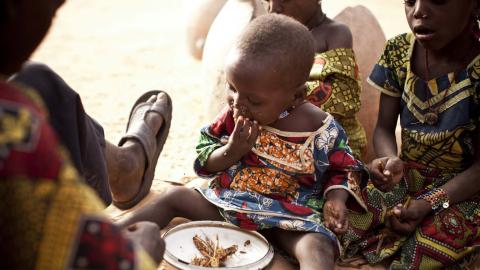
Malnutrition
Increased access to more of the right type of food is essential for a healthy body later in life
Malnutrition
The Facts:
- Right now more than 870 million people in the world do not have enough to eat;
- The vast majority of these people (98 percent) live in developing countries;
- Women make up just over half of the world’s population, but account for over 60% of the world’s hungry;
- Under-nutrition at an early age can have long term effects on a child’s development – currently one in four of the world’s children (173 million) have been left stunted due to lack of appropriate nutrition in early life;
- Undernutrition is an underlying factor in 45% of deaths of children under age five.
The situation:
Children face many more health challenges if they do not have existing good health. Poor nutrition leads to poor general health and can cause a reduced immunity to common illnesses, lower resilience to withstand their effects, and a shorter time between falling ill and dying of often preventable causes. The opposite is also true, that good nutrition leads to a greater resilience to diseases. In short improved nutrition will save lives.
This explains why the developing world bears the brunt of child mortality. Currently 98% of the 870 million people who do not have enough to eat are from developing countries, this can result in high national levels of wasting and stunting as a result of under-nutrition. These factors also indicate nations where children will continue to struggle to recover from illness.
To achieve improved nutrition at an early age, as well as a healthy body later in life, communities in both urban and rural environments deserve greater investment in terms of knowledge, resources and children’s services. In the meantime, supplementary feeding and school nutrition programmes are effective ways to reach individual children with the micro-nutrients they need to develop normally.
What causes malnutrition?
- Insufficient food, or the wrong type of food for a child’s development needs;
- Illnesses, particularly diarrhoea, that affect children’s food intake and digestion;
- Low rates of breastfeeding in infants, or breastfeeding that ends before six months of age;
- Inequity of available food resources; household poverty;
- A cultural or political under-prioritisation of children’s nutritional needs.
What can be done about it?
To reduce the causes of malnutrition:
- More of the right food: greater food security at household and community level, which takes into consideration the nutritional value of the food available (some foods are better for a child’s development than others);
- Greater public awareness: Targeted public health campaigns to share messages and practices of food preparation for infants and under-fives;
- Greater nutritional education: Community action and direction on what is acceptable for their children’s nutrition and development;
- Breast is best: Exclusive breastfeeding to six months.
To reduce the effects of malnutrition (wasting, stunting, poor general health):
- Action: Intervention programmes with supplementary feeding such as Plumpy Nut;
- Monitoring: Community health posts to measure and act on individual cases of malnutrition.